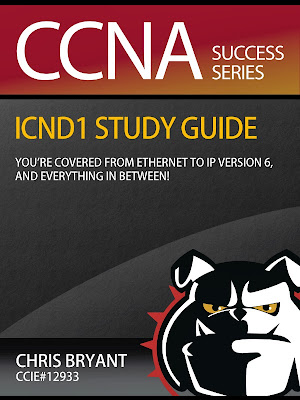Here's your all-new CCNA and CCNP Training Post for Monday, December 9!
I strongly recommend you CCNP candidates out there take this practice exam for a refresher on fundamentals!
And just a quick word... my CCNA and CCENT ICND2 Study Guide will be out later this week!
I strongly recommend you CCNP candidates out there take this practice exam for a refresher on fundamentals!
And just a quick word... my CCNA and CCENT ICND2 Study Guide will be out later this week!
My CCNA and CCENT ICND1 Study Guide is already an Amazon Bestseller, with several 5-star reviews there already!
If you don't have yours yet -- grab it now, they might run out! : )
(Seriously, it's really good. And guaranteed. And 10 bucks!)
And now, your OSPF practice exam!
1. What number is assigned to the LSA type known as a "Network LSA", and that identifies the DR and BDR?
2. A "DROTHER" detects a topology change on an OSPF broadcast segment. What routers will receive notification of that change directly from that DROTHER?
A. The DR only.
B. The DR and BDR only.
C. All routers on the broadcast segment.
D. The other DROTHERS on that particular segment only.
A. The DR only.
B. The DR and BDR only.
C. All routers on the broadcast segment.
D. The other DROTHERS on that particular segment only.
3. To what IP address are OSPF Hellos multicast? (There's a hint to part of the address!)
4. Exactly how often are OSPF Hellos multicast by DRs and BDRs residing on an OSPF broadcast network?
5. Which of the following would NOT interfere negatively with an OSPF adjacency?
A. The interfaces through which the adjacency is forming are on different subnets.
B. The routers involved are using different OSPF process IDs.
C. The routers are using different OSPF RIDs.
D. The adjacent interfaces are using different OSPF hello and dead timers.
E. One interface is set for OSPF stub routing and the other is not.
A. The interfaces through which the adjacency is forming are on different subnets.
B. The routers involved are using different OSPF process IDs.
C. The routers are using different OSPF RIDs.
D. The adjacent interfaces are using different OSPF hello and dead timers.
E. One interface is set for OSPF stub routing and the other is not.
Answers right after this brief, important break!
You have to make a choice.
You can choose to put off your studies until 2014 and lose your momentum totally ...
... or you can be wise and keep hitting your studies now.
My CCNA Video Boot Camp is the best way to keep your success momentum rolling!
... or you can be wise and keep hitting your studies now.
My CCNA Video Boot Camp is the best way to keep your success momentum rolling!
You receive over 27 hours of downloadable, info-packed CCENT and CCNA instruction from yours truly for just $44!
Over 7000 students are already there. Join us now!
Over 7000 students are already there. Join us now!
And now -- the answers!
1. The Network LSA is LSA Type 2.
2. "B". In this scenario, the DROTHER will notify both the DR and BDR of the change. It's then up to the DR to let any other DROTHERS on that segment know what's going on.
3. OSPF Hello packets are multicast to 224.0.0.5.
4. OSPF Hello packets are multicast every 10 seconds by any router on an OSPF broadcast network (not just DRs and BDRs).
5. Going through each scenario....
"A" would interfere with the adjacency.
"B" would not, since the OSPF process ID is locally significant only.
"C" would not, since we like our routers to use different RIDs.
"D" would definitely bring an OSPF adjacency to a halt. Interfaces must agree on OSPF Hello and Dead times in order to form and keep an adjacency.
"E" would get in the way of an adjacency as well. If one interface is sending Hellos with the stub flag set and the other is sending Hellos with that same flag not set, no adjacency will form.
See you Tuesady with another all-new practice exam!
Chris B.
Thanks for making my CCNA ICND1 Study Guide an Amazon Bestseller!




Comments